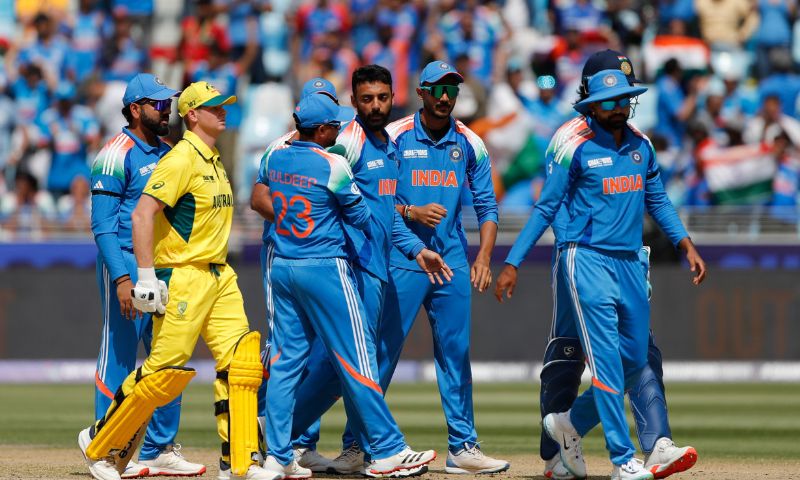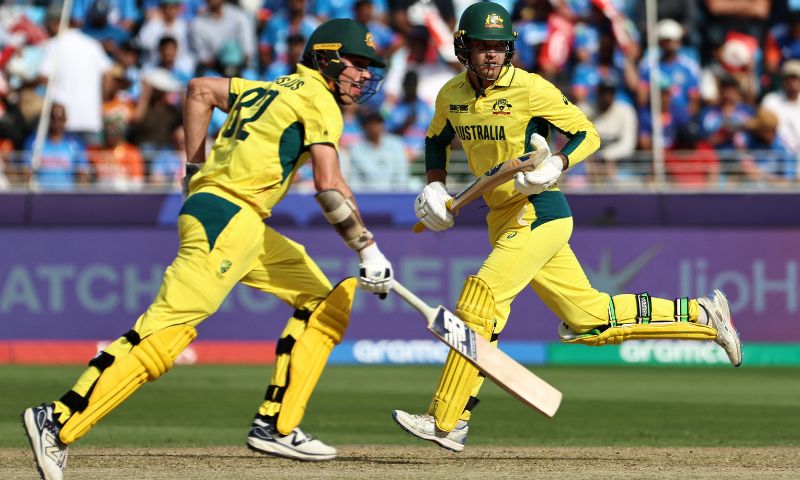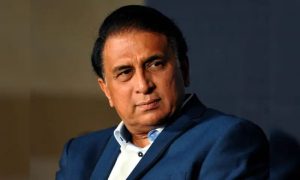DUBAI: Skipper Steve Smith and Alex Carey hit half-centuries as Australia made 264 all out against India in the first semi-final of the Champions Trophy in Dubai on Tuesday.
After choosing to bat, Smith hit 73 and the left-handed Carey smashed 61 to put on the highest total at Dubai International Cricket Stadium in the ongoing 50-over tournament.
India pace spearhead Mohammed Shami stood out with figures of 3-48 as Australia’s innings lasted 49.3 overs. Spinners Varun Chakravarthy and Ravindra Jadeja took two wickets each.
India’s new-ball bowlers tested the Australian openers with a disciplined line and consistently beat the bat before Cooper Connolly finally edged one to wicketkeeper KL Rahul off Shami.
The decision was denied by the on-field umpire but successfully reviewed by India and the left-handed Connolly, a replacement for injured Matthew Short, trudged back to the pavilion for a nine-ball duck.
The left-handed Travis Head hit back with a flurry of fours and two sixes to raise memories of his onslaught against India in the 2023 World Cup final won by Australia.
But wrist spinner Chakravarthy struck on his second ball to get Head caught out at long-off for 39 off 33 balls as India celebrated a big wicket, leaving Australia 54-2.
Smith and Marnus Labuschagne got to the grind and chipped away against the spinners. Labuschagne finally got a boundary after 50 balls.
He brought up 100 for Australia with a six off Axar Patel, prompting India skipper Rohit Sharma to change him next over with Shami.

Shami nearly got a quick breakthrough but failed to hang on to a return catch by Smith on 36.
Jadeja trapped Labuschagne lbw for 29 with his left-arm spin to end the 56-run stand.
Smith reached his 35th ODI half-century but Jadeja got another wicket when Josh Inglis gave away a catch to covers.
Smith stood firm and put on another solid stand of 54 with wicketkeeper Carey as the two found gaps and hit regular boundaries.
Shami finally had Smith bowled on a full toss and soon after Patel rattled the stumps of Glenn Maxwell after being hit for six as Australia lost their way.
Carey reached his fifty and with fellow left-hander Ben Dwarshuis, who hit 19, kept up the charge until Chakravarthy sent back Dwarshuis.
Carey was finally run out after a direct throw from Shreyas Iyer but the total went past the previous best at the venue at this tournament — when India made 249 in beating New Zealand in the last group match.
India have won all three of their games and are playing in Dubai after they refused to tour Champions Trophy hosts Pakistan for political reasons.
The match is the first ODI between India and Australia since the World Cup final.
The winner faces South Africa or New Zealand in Sunday’s final of the eight-nation 50-over tournament.
Steve Smith and Maxwell gone
Axar Patel takes the wicket of Glenn Maxwell after he was hit for a six. Australia are 206 for 6 in 38.2 overs.
Smith misses a full toss as India turns to their fast bowlers, realizing spin isn’t troubling the two set batters. They may now try Varun, Kuldeep, or another spinner.
However, the new batter is a strong spin hitter, and if it’s his day, he could be unstoppable.
Alex Carey’s sweeps
Whether the sweep shot is a pest for spinners or not, it certainly is one for captains. Australia are going well in the match. They are 190 for in 35.2 overs.
Alex Carey played four in his first 18 balls. The last of those to India’s mystery spinner Varun Chakravarthy and it went all the way.
So in the next over, Rohit had mid-on up and square leg back and that meant as soon as Carey picked that Kuldeep had tossed the ball up a bit, he could wind up and launch it. He just had to beat the infield.
Minimal risk for a boundary.
Steve Smith in control
Smith is reading Kuldeep’s deliveries well. In the 32nd over, he plays a straight bat to a wrong ‘un, sending it over the top.
The next ball, a legbreak, sees Smith adjust and safely take a single through midwicket. India must be hoping the ball that rolled back on the stumps had broken the stumps.
Josh Inglis’ dismissal
Ravindra Jadeja strikes again by taking the wicket of the inform Josh Inglis. Smith is batting well. He is joined by Alex Carey. Australia are currently 148 for 4 in 28.4 overs.
Steve Smith fifty
Australia is scoring over 5 an over, a rate India hasn’t allowed in the Champions Trophy, and Steven Smith is making them work hard.
Watching a great batter on a challenging pitch is a treat—his shot selection, focus, and footwork are all sharp. Despite facing 10 consecutive dot balls, Smith remains unfazed, hitting a six and a four in his next seven balls.
However, at the other end, Josh Inglis is dismissed, as Jadeja’s delivery sits up unexpectedly, leading to a catch at short cover.
Marnus Labuschagne’s dismissal
Ravindra Jadeja takes the wicket of Marnus Labuschagne after he was hit for a four. India’s spin attack seems to be proving handy for the bowling side. Australia are 3 down for 120 in 24 overs.
Australia is focusing on scoring off pace, with Travis Head targeting Hardik Pandya in the powerplay and Steven Smith now going after Mohammed Shami.
Smith risks his wicket, nearly being caught off an on-the-up drive that Shami drops in his follow-through.
Despite this close call, Smith stays aggressive, shifting across his stumps to attempt a scoop off the very next ball, after previously charging Shami.
Australia 90/2 after 18 overs
Smith and Labuschagne have provided much-needed stability to the Australian batting line after losing openers early in the match. Australia are currently 91 for 2 in 18 overs.
Run rate has slowed down but Australia need a partnership to set a competitive total on the slow pitch.
Smith gets a lucky break as he inside edges a drive, and the ball hits the off stump hard enough to rebound, yet the bails remain intact. Smith watched the whole sequence unfold, not intervening to avoid possibly disturbing the stumps. This happened on the last ball of Axar Patel’s maiden over (14th).
Spin slows it down
Already signs of what it might be like against spin – only 22 runs off five overs in tandem, and of course the wicket.
Varun Chakaravarthy takes the wicket of Head. Earlier, Kuldeep failed to take the crucial wicket. Seeing the Australian on fire, Rohit Sharma brings in the spin attack. Australia are currently batting at 58 for 2 in 9.1 overs.
The Big One 💪
Varun Chakaravarthy gets the wicket of Travis Head! 🙌 🙌
Shubman Gill with a brilliant running catch 👌👌
Updates ▶️ https://t.co/HYAJl7biEo#TeamIndia | #INDvAUS | #ChampionsTrophy | @chakaravarthy29 | @ShubmanGill pic.twitter.com/5oJERL9b6S
— BCCI (@BCCI) March 4, 2025
Head’s tactics
Earlier, Head excels with the cut and pull shots, and his pick-up shot has been particularly effective, hitting Hardik Pandya for a six and a four, despite the deliveries not being bad.
It shows he’s adapted to the pitch’s lack of pace and targeted Hardik during the powerplay, with only two fielders outside the circle. Head is aggressive and tactical, as Australia reaches 53 for 0 in 7.2 overs.
Shami’s effectiveness drops slightly when bowling over the wicket, which Head exploits with his aggressive hitting. After being 1 off 11, Head is now 26 off 19.
Australia are currently batting at 17 for 1 in 3 overs.
Mohammad Shami dismisses Connolly
From the start, it seemed to be a slow pitch. Cooper Connolly struggled against India’s pace attack. Steve Smith came to bat.
Head dropped
This is a sign of how unhealthy the conditions for stroke play are. Travis Head has played two attacking shots already—a slap through extra cover and a pull off the hips—but neither were timed, and that’s rare.
Former Australia captain Ricky Ponting marvels at the sound off Head’s bat. One of the best readers of the game highlighted how Head might look awkward at times, but he still hits the ball so hard. That’s why the margins of error are so small.
Australia won the toss and decided to bat first in the 1st semi-final of ICC Champions Trophy in Dubai on Tuesday.
🚨 Toss News 🚨
Australia have elected to bat against #TeamIndia in the #ChampionsTrophy Semi-Final!
Updates ▶️ https://t.co/HYAJl7biEo#INDvAUS pic.twitter.com/tdkzvwJfyu
— BCCI (@BCCI) March 4, 2025
The four stalwarts—South Africa, Australia, India, and New Zealand—have consistently reached the semi-finals, both in the 2023 and 2015 World Cups, with Australia emerging victorious in both tournaments.
In the final of the ICC Cricket World Cup 2023 held on November 19 at the Narendra Modi Stadium in Ahmedabad, India set a total of 240 runs in their allotted 50 overs.
Australia chased down the target with ease, finishing at 241 for 4 in just 43 overs, securing a 6-wicket victory. Travis Head was the star of the show, smashing an impressive 137 runs off 120 balls, complemented by Marnus Labuschagne’s steady contribution of 58 not out from 110 deliveries.
Cricket enthusiasts from the host nation Pakistan have voiced mixed sentiments, with many asserting that India boasts unparalleled depth in both batting and bowling, and displaying a resilience unmatched by their competitors.
Given India’s recent form, many fans are optimistic about their chances against Australia. However, some remain wary, pointing to India’s historical struggles against the Aussies, particularly in high-stakes matches, supported by statistics that highlight Australia’s dominance in major tournaments and head-to-head clashes.
India has swept through the group stage with an impressive clean slate, securing victories in all three of their matches.
In contrast, Australia faced a turbulent journey, grappling with two washed-out games and managing to complete only one, which they won.
The batting prowess of Virat Kohli and Shubman Gill shone brightly as they both notched centuries, while Rohit Sharma showcased his bold Powerplay strategy, albeit with challenges in converting promising starts into substantial scores.
Shreyas Iyer has emerged as a vital asset, delivering back-to-back fifties during pivotal moments, and Axar Patel has dazzled with his dual contributions, skillfully managing the middle overs and bolstering the batting lineup.
However, India’s pace attack raises some eyebrows, as Mohammad Shami is still searching for his rhythm after a lengthy injury hiatus.
The team’s four-spinner tactic, particularly showcased by Varun Chakaravarthy’s stunning five-wicket haul against New Zealand, has sparked a selection conundrum.
Varun stepped in for Harshit Rana in that match, while Hardik Pandya opened the bowling alongside Shami. The pressing question now looms: will Rana reclaim his spot in the playing XI, and if so, who will make way for him?
On the other hand, Australia faces a challenge with the news that Matthew Short will be sidelined due to a quad injury, paving the way for Cooper Connolly to step in as his replacement.
Short’s absence is a significant loss, impacting not only their batting lineup but also their bowling strategy, as his off-spin would have thrived in Dubai’s spin-friendly conditions.
Jake Fraser-McGurk seems the most straightforward choice to fill the opening, yet Aaron Hardie and Connolly bring versatility with their dual abilities with bat and ball.
On a brighter note, Travis Head has shown signs of regaining his form, although rain interrupted his innings against Afghanistan.
Meanwhile, Josh Inglis and Alex Carey will carry the momentum from their stellar performances during the thrilling chase against England. As always, Marnus Labuschagne and captain Steve Smith will play pivotal roles against India’s formidable spin attack.
Despite acknowledging he’s not at his peak, Adam Zampa remains a vital asset in conditions that should favor him. With a coveted spot in the final at stake, both teams are faced with critical selection dilemmas.
Having played all their games in Dubai, India is well-acquainted with the slow and low pitch conditions, while Australia has been navigating their journey primarily in Pakistan, with a focus on Lahore, though their match in Rawalpindi against South Africa was unfortunately washed out without a single delivery bowled.
A thrilling confrontation looms on the horizon as two of cricket’s most formidable adversaries gear up for a knockout bout. Will India manage to rewrite their narrative this time around, or will Australia once again put the brakes on their momentum?
India’s last victory over Australia in an ICC knockout showdown dates back to the 2011 World Cup quarterfinal.
Since then, they’ve faced disappointment against the Australians in pivotal matches, including the semifinals of the 2015 World Cup, the finals of the 2023 World Cup, and the 2023 World Test Championship final.
As India gears up for yet another intense clash with Australia, let’s delve into their ODI head-to-head record:
India vs. Australia: Head-to-Head in ICC Champions Trophy
India lead 2-1 in four encounters (one no result)
1998: India won by 44 runs (Dhaka)
2000: India won by 20 runs (Nairobi)
Overall (151 ODI’s)
Australia: 84
India: 57
No result: 10
In ICC ODI World Cups (14 Matches)
Australia: 9
India 5
India Squad
Rohit Sharma (c), Shubman Gill, Virat Kohli, Shreyas Iyer, Axar Patel, KL Rahul (wk), Hardik Pandya, Ravindra Jadeja, Mohammed Shami, Kuldeep Yadav, Varun Chakravarthy.
Australia Squad
Josh Inglis (wk), Travis Head, Steve Smith (c), Marnus Labuschagne, Cooper Connolly, Alex Carey, Glenn Maxwell, Ben Dwarshuis, Adam Zampa, Nathan Ellis, Tanveer Sangha.


























